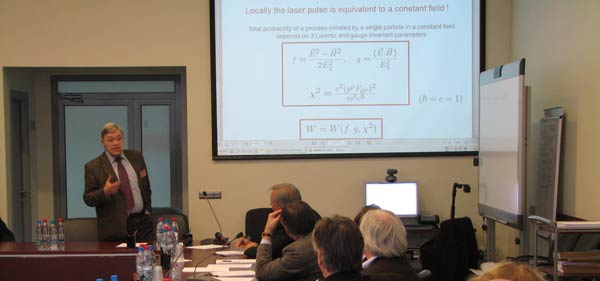“Russian ELI/HiPER/PETAL at ISTC” Workshop, 24-25 November, Moscow

The International Science and Technology Center hosted the International Workshop “Russian ELI/HiPER/PETAL at ISTC” on November 24 and 25, 2008, at its Secretariat in Moscow. The event brought together for the first time a critical mass of top Russian scientists/institutes active in the field of high intensity laser physics with their European counterparts working on the large scale projects ELI, HiPER and PETAL. Close to 50 people attended the event.
The objective of the meetings was to formulate collaborative research objectives and discuss legal and financial mechanisms for their implementation. The participants identified the scope, the partners and possible forms of a future coordination and collaboration. Furthermore, the workshop provided a platform to demonstrate the high level and the important contribution of Russian scientists to extreme light science research and technologies. The results of their research are in many cases complementary to those obtained in the EU countries.
The workshop demonstrated the enormous potential of high power and high intensity lasers for fundamental science, material processing and medicine. This is a very broad and promising area of research, which encompasses all three abovementioned EU projects, although each of them would require separate mechanisms of collaboration at the regional, institutional, national or European levels. This domain needs for its successful development further public and governmental support. An efficient collaboration requires proper legal decisions and funding mechanisms that have to be clearly identified and implemented.
Among the possible funding mechanisms the following options have been identified:
- The ISTC partner projects based on the funding that is currently available within the HiPER and possibly ELI programs, and The ISTC science (regular) projects;
- Allocation of a special Russian fund through the Russian Foundation for Basic Research (RFBR), the Russian Academy of Sciences (RAS), and other sources to support the initiatives of Russian laboratories and to support the work within the Russian Federation (RF) in concerted action with the EU partners;
- EU/Russia collaboration within the existing bilateral agreements between the RAS, RFBR and EU partners (CNRS in France, DAF in Germany, STFC in UK). These agreements offer essentially mobility funds that can be supported to some extent by additional funds from each side. Three collaboration forms have been identified: lab-to-lab exchange agreement, exchange networks between the collaborating laboratories, and virtual laboratories (laboratories without frontiers);
- In-kind or direct Russian funding of EU projects. This would be the most efficient form of collaboration, which would allow the Russian scientists a direct participation in planning and construction of the EU laser facilities and a privileged access to them afterwards.
The workshop also identified a list of high priority subjects and the scientific groups that are interested in collaboration. The conclusions suggest short-term actions that could be readily initiated and that would allow to enable the collaboration immediately.
The workshop summary is under the ratification. The agreed version will be translated into Russian and approved by written procedure by all institutions that participated in the event. Then this document will be available on the ISTC website.
For more information, contact:
Yuri Malakhov
Principal Senior Project Manager, ISTC
Email: malakhov@istc.ru
Phone: 7 495 982-3157
Click here to access the final summary of the event
Click here to access the program of the event
Click here to access the list of presentations
List of Participants
ISTC
1. Secretariat, Moscow: Waclaw Gudowski, Yuri Malakhov,
EU
2. Mike Dunne, Director of the Central Laser Facility at FTFC Rutherford Appleton Laboratory,
3. Gerard Mourou, Director Laboratoire d’Optique Appliquee (LOA) at ENSTA,
4. Georg Korn, ELI Deputy Coordinator, Max-Planck-Institut fur Quantenoptik, Hans-Kopfermann-Str. 1, 85748 Garching
5. Christine Labaune, Director of the Institute Lasers and Plasmas-CNRS-CEA-Ecole Polytechnique-University Bordeaux
6. Vladimir Tikhonchuk, Professor of the Centre Lasers Intenses et Applications
7. Guy Schurtz, CELIA, scientific coordinator of WP9-11 for HiPER
8. Jacques Ebrardt, CEA/DAM, Project Leader
9. Daniel Malys, CEA
10. Vladimir Mayer, CNRS
Japan
11. Sergei Bulanov, Advanced Photon Research Center, Japan Atomic Energy Agency
Russia
12. RFNC-VNIITF, Snezhinsk: E.N. Avrorin, E. Loboda, A. Potapov
13. RFNC-VNIIEF, Sarov: G. Kochemasov, V. Vatulin, V. Rogachev
14. Lebedev Physics Institute RAS: V.Bychenkov, S.Guskov, A.Shikanov, A. Rupasov, N. Borisenko, E. Koresheva, L. Mikheev
15. Prokhorov General Physics Institute RAS: I. Sherbakov, M. Lyamshev, P. Pashinin
16. Institute of Applied Physics RAS: E. Khazanov, A. Babin, I. Gonoskov
17. Institute for High Temperatures RAS: V. Fortov, N. Andreev, K. Khishchenko
18. Moscow Engineering Physics Institute, MEPhI: N. Narozhny, A. Petrovskij
19. Lomonosov Moscow State University: V. Platonenko
20. Vavilov State Optical Institute, GOI: N. N. Rozanov
21. Keldysh Institute of Applied Mathematics RAS: N. Zmitrenko
22. Institute of Problems of Chemical Physics RAS: I. Lomonosov
23. Institute of Laser Physics SB RAS: S. Bagaev, E. Pestryakov
24. Russian Foundation for Basic Research: A. Zheltikov


